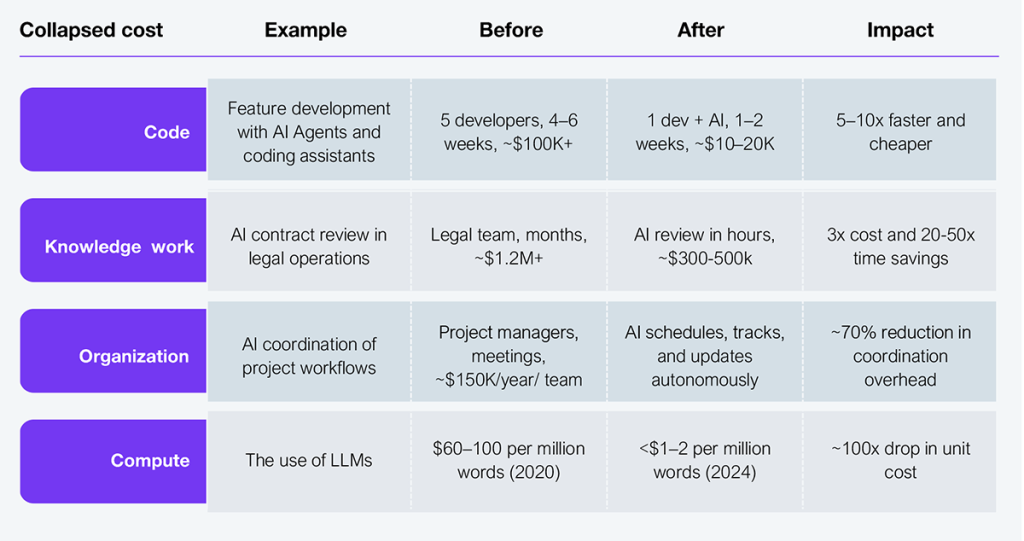Artificial Intelligence (AI) is radically shifting the economics of enterprise operations. Four forces—the collapsing cost of code, knowledge work, organization, and compute—intersect across four operational layers: process, business architecture, applications, and tech architecture.
No leader can afford to ignore the cost shifts happening right now. They are making now the best time yet to tackle ‘the death spiral of legacy debts’ that HFS calls out in our 2030: Services-as-Software vision.
By understanding the impact of each force on each layer (see Exhibit 1), enterprise leaders can shape their own vision of the HFS Generative Enterprise and identify the post-AI operations that enable unprecedented efficiency, speed, agility, and strategic advantage.
HFS’ Generative Enterprise articulates the pursuit of AI technologies based on large language models (LLMs) such as GPTs, and agentic AI, to reap huge business benefits for organizations by continuously generating new ideas, redefining how work gets done, and disrupting business models steeped in decades of antiquated process and technology.
Our framework offers leaders a way to explore the impact of the four collapsing costs across four operational enterprise enablers:

Source: HFS Research, 2025
1. The collapsing cost of code
AI-driven tools—agents included—significantly reduce the time, effort, and expense of defining business requirements as well as developing, testing, maintaining, and modernizing software, empowering faster innovation and crushing the software development lifecycle.
2. The collapsing cost of knowledge work
AI dramatically lowers the cost of complex cognitive tasks—analysis, synthesis, and strategic decision-making—traditionally requiring highly skilled human resources, changing workforce dynamics and business processes.
3. The collapsing cost of organization
Agentic AI technologies and data modernization can streamline coordination and management, reducing organizational friction and overhead, simplifying structures, and enhancing responsiveness.
4. The collapsing cost of compute
The rapid decline in computational costs enables enterprises to modernize, enabling sophisticated AI-driven applications at scale, analytics, and simulations, turning new possibilities into commercial reality with each breakthrough.

Source: HFS Research, 2025—discrete examples are illustrative and certainly NOT exhaustive
Let’s briefly explore how each of these collapsing costs impacts process, business architecture, applications, and tech architecture:
Impacts on your processes
Impacts on your business architecture
Impacts on your applications
Impacts on your tech architecture
Proactively modernize legacy systems: Prioritize modernization initiatives previously deferred due to complexity, using AI to dramatically lower costs and timelines. Tech debt is a drag on performance and innovation.
Rethink workforce strategies: Recalibrate workforce planning, emphasizing skill transformation to complement AI-driven cognitive capabilities. Consider the impact of agentic AI on team structures.
Embrace organizational agility: Flatten hierarchies, empower autonomous teams, and adopt AI-driven management to enhance agility.
Drive innovation through experimentation: Leverage collapsing compute costs to foster continuous experimentation and innovation at scale. Look out for our forthcoming guide to identifying the signal among the noise.
Establish robust AI governance: Implement oversight frameworks to manage AI-driven operational, ethical, and competitive risks effectively. Incorporate this into routines and applications as much as possible to avoid governance by committee.
The convergence of AI-driven collapsing costs represents a historic opportunity for enterprise leaders. Embrace these shifts proactively and you will rapidly pay down your legacy debts to position your organization for sustained competitive advantage, unparalleled agility, and transformative innovation.
Access to capability and possibility is scaling by the day. So, keep a clear head as the opportunity for innovation explodes all around. HFS thinks this will demand a new approach to innovation pipelines—which we will publish shortly.
Register now for immediate access of HFS' research, data and forward looking trends.
Get StartedIf you don't have an account, Register here |
Register now for immediate access of HFS' research, data and forward looking trends.
Get Started